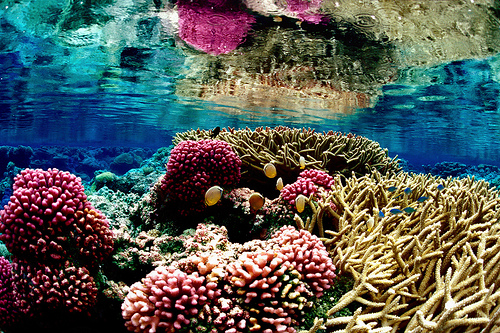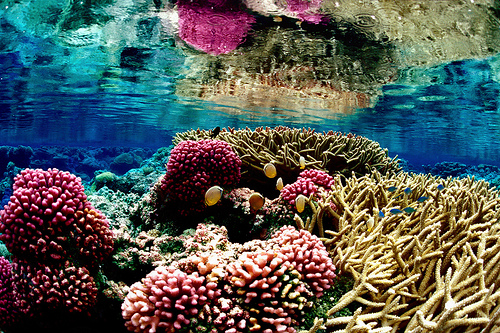 Photo: U.S. Fish & Wildlife Service — Pacific RegionCoral reefs are in big trouble worldwide — and that’s not just bad news for snorkelers. It could mean death instead of life for millions of people … maybe even you.
Photo: U.S. Fish & Wildlife Service — Pacific RegionCoral reefs are in big trouble worldwide — and that’s not just bad news for snorkelers. It could mean death instead of life for millions of people … maybe even you.
Here’s why: Coral already provides the elemental compounds for a growing number of crucial medicines and health products — ranging from antiviral drugs like Ara-A and AZT to anti-inflammatories, painkillers, and even sunblocks. But science is in a race against time: We’ve just started to plumb the depths of coral’s potential to attack the world’s health issues … only to have many reefs on the brink of disaster from threats like warming oceans and overfishing.
So who better than two doctors to make the case for coral as a life preserver? Bruce Chabner, professor of medicine at Harvard Medical School and director of clinical research at Massachusetts General Hospital’s Cancer Center, and Daniel Gruenberg, oncologist at Northwest Cancer Specialists in Portland, Ore., sat down with my Nature Conservancy colleagues Kerry Crisley and Jen Newlin to find out what makes coral so valuable for the medical community — and how we can act to help reefs keep healing us.
Q. What is it about the ocean — and coral reefs in particular — that make it a valuable source of medical research?
A. Chabner: There’s an enormous amount of life in our oceans, particularly in coral reefs. Where you have high concentrations of different organisms living together in one place, you have a treasure trove of unique microorganisms — and compounds produced by those organisms — not found elsewhere on Earth.
Q. This recent report by the World Resources Institute — which says that 75 percent of the world’s coral reefs are in trouble — how much does that worry you?
A. Chabner: First, I firmly believe that coral reefs should be protected in their own right so we can be good stewards of our natural habitat. But we have only scratched the surface of what the reefs can offer medically. The sea could very well hold the building blocks of drugs that could treat, or even cure, cancer. We don’t know. But if we lose the reefs, we’ll never find out.
Gruenberg: We think a lot about nature in our anti-cancer strategy. In the oceans, when we trawl in ways that carve up the ocean bottoms, we’re removing organisms we didn’t even know existed that could be valuable for treating cancer, not to mention things like heart disease or diabetes.
One other thing we should think more about is indigenous cultures. These societies have ways of treatment that we don’t fully understand — rich histories in natural healing strategies that may be relatable to other communities. Who knows what can be found in prairie grasses, for instance, that’s beneficial? There are so many natural opportunities we know nothing about. And we don’t have a lot of time to figure it out.
Q. With cancer drugs — how many do we get from nature? And how did science figure out the connection?
A. Gruenberg: More than 90 percent are derived from natural sources. Actually, even drugs like Cytoxan come from nitrogen mustard, as in the gas used in World War I. How did they figure out it had anti-cancer properties? From autopsies at that time, they saw that lymph nodes shrank. Of course it killed a lot of other cells, too. But it’s become important in the treatment of cancers like lymphoma. So I’d actually revise that to say that 99.9 percent of our drugs are naturally derived.
The oncology field has changed so much in 20 years, considering all that we’ve learned about cell division and the immune system. Not only do I see improved survivorship and outcomes, but there’s less toxicity to medications we use. And there are more supportive medicines and natural medicines because of natural sources and better understanding of natural processes. It’s remarkable.
Q. How does getting it from sea to pill work? How does one go from looking at, say, a sea squirt to creating a new drug?
A. Chabner: We start by studying the organism. How does it grow? How does it defend itself? How does it survive in its surroundings? When we’ve found the specific compounds that contribute to its survival we can see where it might be effective in treating certain types of cancers. The drug Ara-C, for example, is the backbone of chemotherapy for leukemia and lymphoma. That was derived from a sea sponge in the Caribbean.
Q. Do we have to keep harvesting the reefs to maintain supplies of these medicines?
A. Chabner: That’s the best part; in most cases, no. Once the compound has been isolated it can often be synthesized and created in the lab. What’s important is that we discover it while it’s still there in our oceans.
Q. Alzheimer’s disease and strokes — there are other marine-based drugs being tested that show tremendous promise in the treatment of these conditions. What else? Are there new drugs in the works?
A. Chabner: Yes. Several new medicines for the treatment of lymphoma and ovarian, breast, and prostate cancers have gone through their clinical trial phases and are close to receiving FDA approval. And — equally exciting — other marine-based medicines are showing tremendous promise in the treatment of strokes and Alzheimer’s disease.
Q. Bring it down to a personal level. Give us one thing that anyone could do to keep the nature-medicine connection a healthy one.
A. Gruenberg: One simple thing is to eat local. It’s good for our bodies. There’s less transport so less pollution and use of fossil fuels. There’s less disturbance to the natural environment and indigenous cultures. You know the agricultural source and it’s local to you and your system and environment.
Q. Do you follow your own advice?
A. Gruenberg: As much as possible. And I try not to eat anything out of season.


